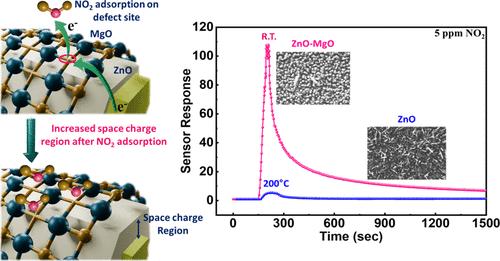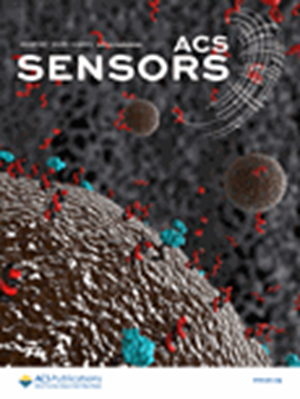Unleashing the Potential of Tailored ZnO–MgO Nanocomposites for the Enhancement of NO2 Sensing Performance at Room Temperature
IF 9.1
1区 化学
Q1 CHEMISTRY, ANALYTICAL
引用次数: 0
Abstract
Surface functionalization of semiconducting metal oxides has emerged as a highly effective approach for enhancing their sensing capabilities. In the present work, the surface of randomly oriented zinc oxide (ZnO) nanowires is modified with an optimized thickness (7 nm) of magnesium oxide (MgO), which exhibits an exceptionally sensitive and selective behavior toward NO2 gas, yielding a response of approximately 310 for 10 ppm concentration at room temperature. The synergistic interplay between ZnO and MgO leads to a remarkable 20-fold improvement in sensor response compared to a pristine ZnO film and allows the detection of concentrations as low as 50 ppb. The ZnO–MgO composite was characterized using X-ray diffraction (XRD), XPS, and SEM-EDS to gain structural, compositional, and morphological insights. The interaction of the NO2 molecule with the sensor film was investigated using density functional theory (DFT) simulations, revealing that oxygen vacant sites on the MgO surface are most favorable for NO2 adsorption, with an adsorption energy of −3.97 eV and a charge transfer of 1.74e toward NO2. The XPS, photoluminescence (PL), and EPR measurements experimentally verified the presence of oxygen vacancies in the sensing material. The introduction of localized levels within the band gap by oxygen vacancies significantly promotes the interaction of gas molecules with these sites, which enhances the charge transfer toward NO2 gas molecules. This augmentation has a profound influence on the space charge region at the ZnO–MgO interface, which is pivotal for modulating the charge transport in the ZnO layer, resulting in the substantial improvement of NO2 response at room temperature.

释放定制氧化锌-氧化镁纳米复合材料的潜力,提高室温下的二氧化氮传感性能
半导体金属氧化物的表面功能化已成为增强其传感能力的一种非常有效的方法。在本研究中,无规取向的氧化锌(ZnO)纳米线表面经过了厚度(7 nm)优化的氧化镁(MgO)修饰,对二氧化氮气体表现出异常灵敏的选择性,在室温条件下,10 ppm 浓度的二氧化氮响应约为 310。与原始氧化锌薄膜相比,氧化锌和氧化镁之间的协同作用使传感器的响应显著提高了 20 倍,可检测低至 50 ppb 的浓度。我们使用 X 射线衍射 (XRD)、XPS 和 SEM-EDS 对 ZnO-MgO 复合材料进行了表征,以深入了解其结构、组成和形态。利用密度泛函理论(DFT)模拟研究了二氧化氮分子与传感器薄膜的相互作用,结果表明氧化镁表面的氧空位最有利于二氧化氮的吸附,其吸附能为 -3.97 eV,向二氧化氮的电荷转移为 1.74e。通过 XPS、光致发光 (PL) 和 EPR 测量,实验验证了传感材料中氧空位的存在。氧空位在带隙内引入的局部电平极大地促进了气体分子与这些位点的相互作用,从而增强了对二氧化氮气体分子的电荷转移。这种增强对 ZnO-MgO 界面的空间电荷区产生了深远的影响,而空间电荷区对于调节 ZnO 层中的电荷传输至关重要,从而大大改善了室温下的二氧化氮响应。
本文章由计算机程序翻译,如有差异,请以英文原文为准。
求助全文
约1分钟内获得全文
求助全文
来源期刊

ACS Sensors
Chemical Engineering-Bioengineering
CiteScore
14.50
自引率
3.40%
发文量
372
期刊介绍:
ACS Sensors is a peer-reviewed research journal that focuses on the dissemination of new and original knowledge in the field of sensor science, particularly those that selectively sense chemical or biological species or processes. The journal covers a broad range of topics, including but not limited to biosensors, chemical sensors, gas sensors, intracellular sensors, single molecule sensors, cell chips, and microfluidic devices. It aims to publish articles that address conceptual advances in sensing technology applicable to various types of analytes or application papers that report on the use of existing sensing concepts in new ways or for new analytes.
 求助内容:
求助内容: 应助结果提醒方式:
应助结果提醒方式:


